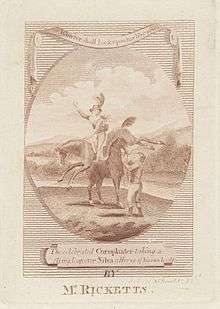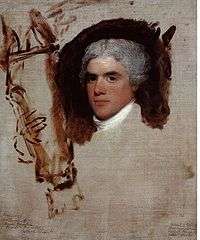John Bill Ricketts

John Bill Ricketts (1769–1800) was an English[1] equestrian who brought the first modern circus to the United States.
Biography
Ricketts began his theatrical career with Hughes Royal Circus in London in the 1780s, and came over from Britain in 1792 to establish his first circus in Philadelphia. He built a circus building in Philadelphia in the fall of 1792 in which he conducted a riding school. After training a group of Pennsylvania horses, on April 3, 1793, he gave America's first complete circus performance, which began a series of exhibitions two and three times a week.[2] George Washington appears to have gone to at least one of his performances. In December 1799 his circus building burned down. Ricketts sailed to the West Indies on the schooner Sally, but the ship was intercepted by a French privateer and taken to the island of Guadeloupe.[3] Eventually, Ricketts was able to recover some of his horses and property and even managed to perform some shows on Guadeloupe. Ricketts was able to recover his fortunes enough to charter a small if unreliable ship, intending to return to England. Unfortunately somewhere on this voyage his ship sank, and all on board were lost.[4]
Gilbert Stuart portrait

Ricketts is identified as the subject of an unfinished portrait of ca. 1795–99 by Gilbert Stuart. The painting's current provenance includes the sitter's brother, Francis Ricketts; it was later owned by Peter Grain and George Washington Riggs.[5] In 1879, George C. Mason published The Life and Works of Gilbert Stuart, in which he described the painting as "an unfinished picture, which, there is strong reason for believing, was painted by Stuart" and identified the subject as Breschard, the Circus Rider.[6] It was under this title that the painting was displayed at the Museum of Fine Arts, Boston in 1880.[7] In 1942 the painting entered the collection of the National Gallery of Art, which changed the identification to "John Bill Ricketts" by 1947.[8]
See also
References
- ↑ Jando, Dominique (2018). Philip Astley and The Horsemen Who Invented The Circus. Circopedia. p. 95. ISBN 978-1984041319.
- ↑ Explore PA history.com - Historical Markers
- ↑ Whitman, Matthew. "John Bill Ricketts, One Mystery Unraveled". www.matthewwhitman.com. Retrieved 6 June 2018.
- ↑ John Bill Ricketts
- ↑ NGA website: John Bill Ricketts—provenance
- ↑ Mason, George C. The Life and Works of Gilbert Stuart. New York, NY: Charles Scribner's Sons, 1879. p. 151.
- ↑ NGA website: John Bill Ricketts—bibliography
- ↑ NGA website: John Bill Ricketts—exhibition history
- ↑ Tattersfield, Nigel (December 2013). ‘Caught in the Act: John Bill Ricketts as Glimpsed by Thomas Bewick’. Print Quarterly (XXX, No. 4): pp. 422-426.
Further reading
- Batson, Kim (2013). "Transatlantic Journeys: John Bill Ricketts and the Edinburgh Equestrian Circus". Popular Entertainment Studies. 4 (2): 5–28. Retrieved 15 April 2014.
External links